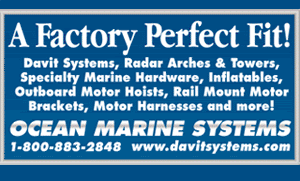Bud Harris and crew aboard the Newport, RI based Hunter 44
Paradise won their class in the recent
Figawi race from Hyannis, MA to Nantucket MA.
With a reputation for robust post-race social activities, the annual 20 mile season opener drew over 200 entrants this year. Rob Lawnsby of
Advantage Yacht Sales (a friend of Bud's) sent in this preliminary report.
"Bud is not a racer guy, in fact this is probably one of the first races he has been in with his boat.
Paradise has a standard mainsail, shoal draft keel, bow thruster and plenty of liveaboard personal belongings. He is a performance guy however, and knows how to trim sails and get speed.
Wind for the "pursuit" style start was about 20 knots on the beam. With a team of 7 friends as crew, they focused on keeping their speed up, and finding the right path between all the boats that had started ahead. They passed 80 boats during the 2 1/2 hour race, including last years winner and averaged over 8 knots. The faster boats that started later never caught up and they were all by themselves when the crossed the finish line.
Bud said the boat screamed along for the entire race leaving the passed boats in a wake of disbelief. The race was a serendipitous combining of Glen Henderson's hull, Bud Harris's sailing skills, and wind direction/speed that let the Hunter 44 shine.
He used the mainsail that came with the boat four years ago with new battens, and had a new jib the same size as the stock jib. He has made improvements to the traveler and put adjustable lines on the jib tracks."
We look forward to seeing the photos and detailed report that Rob has promised soon.
Congratulations Bud & Crew!



 Acrylics and polycarbonates are varieties of hard plastics commonly used on porthole lenses, windscreens, and instrument covers. These plastics cost at least twice that of vinyl. Thick sheets can be ultra-hard, with enormous tensile strength and tremendous clarity, even better than glass. Moreover, polycarbonates have 100 times the impact resistance of glass, but weigh less than half. These properties make polycarbonates a good alternate choice for eyeglasses and airplane windshields. Don’t test it, but a half-inch-thick piece of Lexan should stop a bullet. Lexan is virtually shatterproof, while Plexiglas® acrylic will shatter. These plastics are far more resistant to UV degradation than vinyl.
Acrylics and polycarbonates are varieties of hard plastics commonly used on porthole lenses, windscreens, and instrument covers. These plastics cost at least twice that of vinyl. Thick sheets can be ultra-hard, with enormous tensile strength and tremendous clarity, even better than glass. Moreover, polycarbonates have 100 times the impact resistance of glass, but weigh less than half. These properties make polycarbonates a good alternate choice for eyeglasses and airplane windshields. Don’t test it, but a half-inch-thick piece of Lexan should stop a bullet. Lexan is virtually shatterproof, while Plexiglas® acrylic will shatter. These plastics are far more resistant to UV degradation than vinyl.






